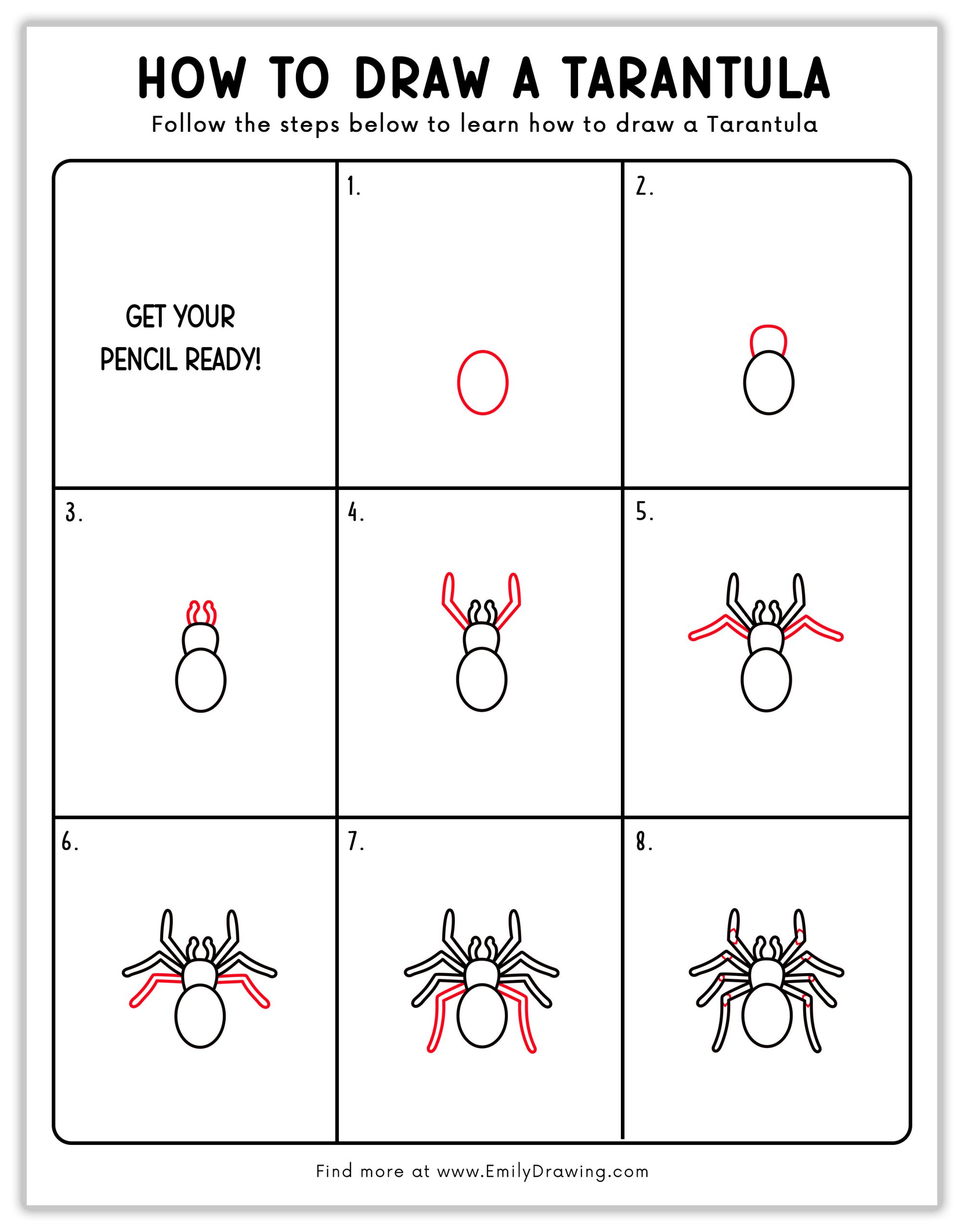Hey there, parents and young artists! Are you ready to dive into the fascinating world of drawing? In this tutorial, we’ll learn how to draw a tarantula in just a few simple steps! Tarantulas might look a little scary, but they are fascinating creatures! Whether you’re a beginner or experienced artist, this guide will help you draw one step-by-step. Whether you’re a beginner or an experienced artist, this cartoon tarantula drawing guide will help you create a creepy-crawly masterpiece. So, grab your pencil, and let’s get started!
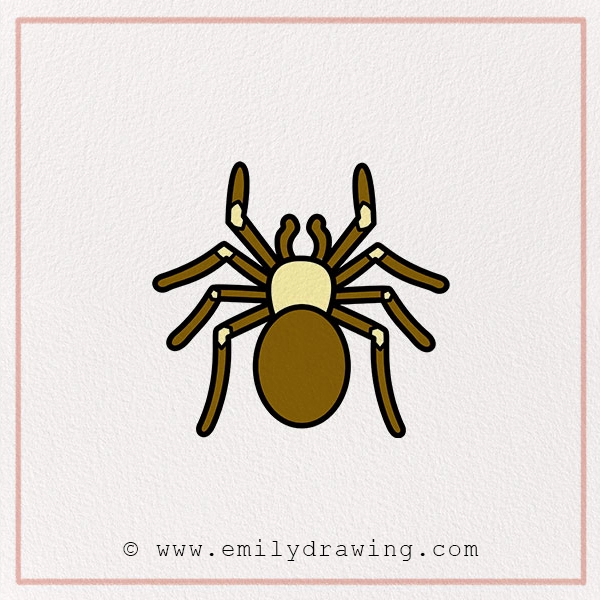
Materials:
- a piece of paper
- a pencil for the guiding lines and sketching
- an eraser
- a black sharpie or a pen for the outlines
- markers or colored pencils for coloring
- our printable drawing guide (Join my Email List below to get this Tutorial)
Here are my RECOMMENDED Art Supplies!
- Crayola Coloring Set (140 Pieces – Mega Value!)
- 24 Colored Crayon Set
- A4 Printer Paper
- Crayola Coloring Pencils
- HP Home Printer with Instant Ink!
Time needed:
15 minutes.
How to Draw a Tarantula — Let’s get started!
Step 1 – Draw the Abdomen

Start by drawing a large oval shape near the center of your page. This will be the tarantula’s big, rounded abdomen, which is the largest part of its body. Make sure to leave enough space on your paper for the head and legs. If you’re not confident with freehand drawing, try sketching lightly in pencil so you can erase and adjust if needed.
Tip: To make the abdomen look more natural, slightly flatten the bottom of the oval to mimic the tarantula’s real shape.
Step 2 – Add the Head
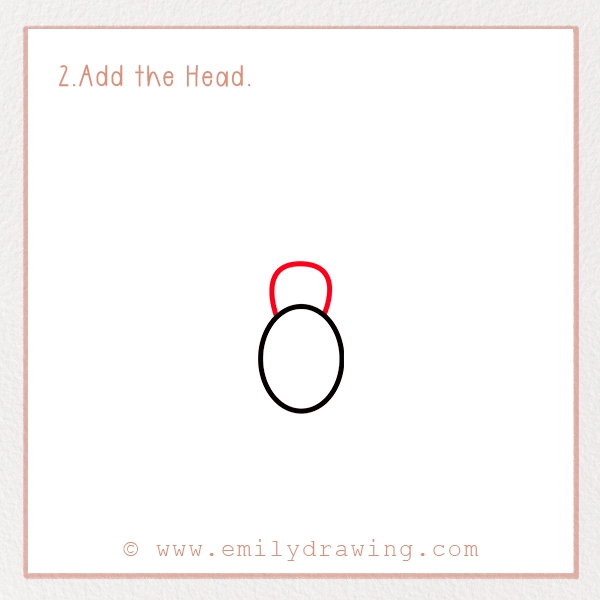
Now, draw a smaller circle above the abdomen to begin illustrating the tarantula’s spider anatomy—this part is called the cephalothorax. This part of the body connects to the legs and fangs, so ensure it’s positioned slightly overlapping the abdomen.
Fun Fact: Unlike most spiders, tarantulas don’t spin webs to catch prey. Instead, they hunt their food on the ground!
Step 3 – Draw the Fangs
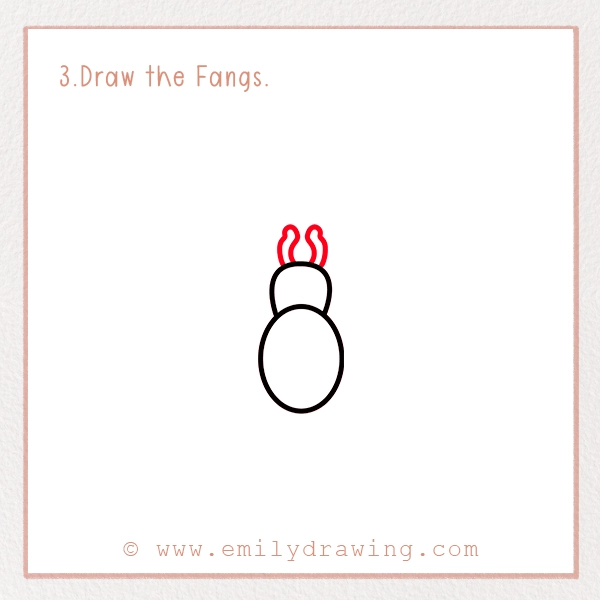
At the front of the head, add two small, curved shapes for the tarantula’s fangs. These should be slightly hooked to resemble how tarantulas catch their prey. The fangs are an important feature, as tarantulas use them to inject venom into their food.
Tip: If you want your tarantula to look extra scary, make the fangs larger and more curved!
Step 4 – Add the Front Legs
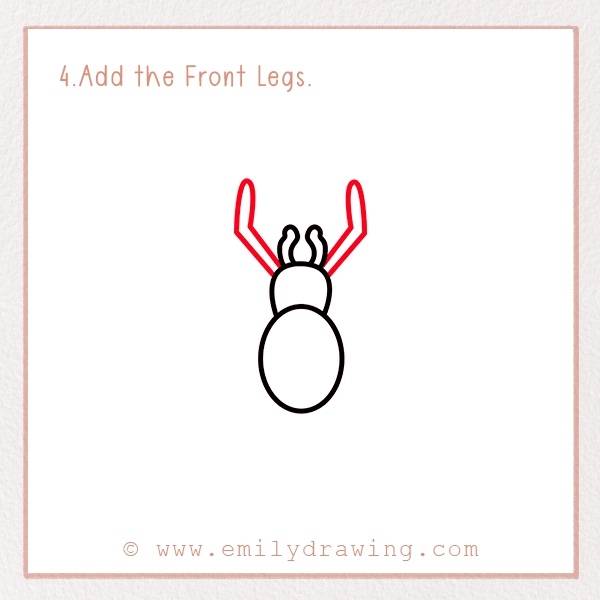
Tarantulas have eight legs! Start by drawing two curved lines on each side of the head. These will be the front legs. Make them slightly bent to show how tarantulas move naturally. Tarantulas’ legs are long and jointed, so ensure you add a few segments to give them a realistic look.
Fun Fact: Tarantulas use tiny hairs on their legs to sense vibrations and detect nearby prey.
Step 5 – Add the Second Pair of Legs
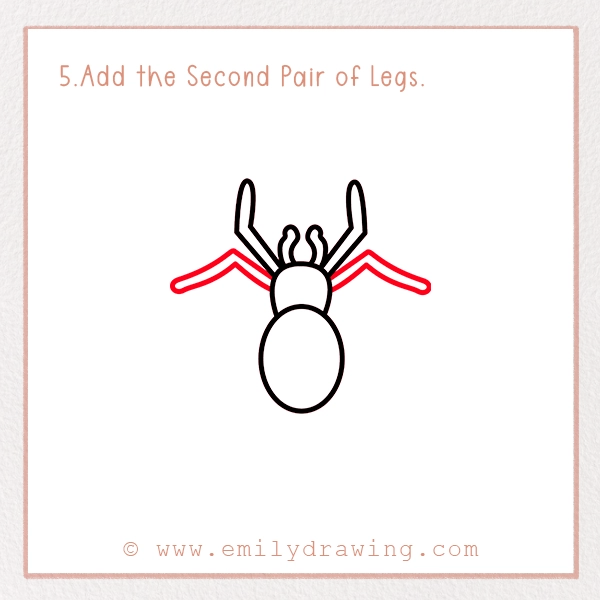
Now, draw another pair of legs on each side, coming from the middle of the body. These should also be curved and slightly angled outward, just like the front legs. Remember, tarantula legs are never perfectly straight – they have a natural bend to them.
Tip: To make the legs look realistic, add small notches or segments at the joints.
Step 6 – Add the Third Pair of Legs
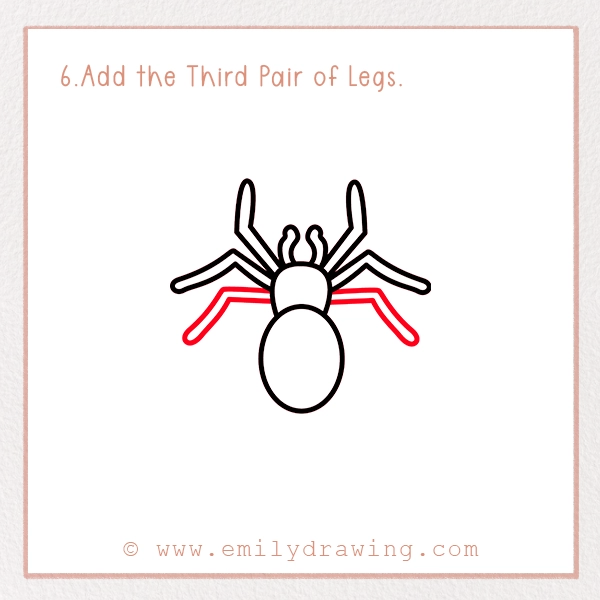
Continue by adding two more legs, positioned slightly behind the previous ones. These should follow the same curved pattern, extending outward and slightly downward. The legs play a crucial role in the tarantula’s movements, helping it crawl and balance as it hunts.
Fun Fact: Tarantulas are excellent climbers and can scale vertical surfaces thanks to tiny claw-like structures at the tips of their legs!
Step 7 – Add the Last Pair of Legs
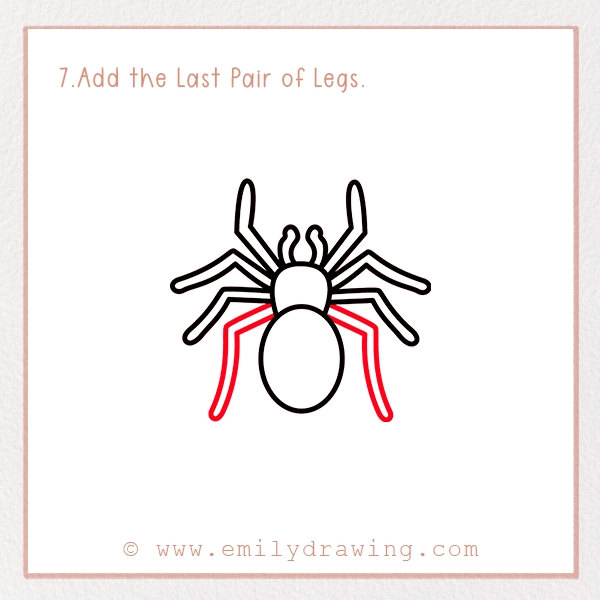
Finally, complete the tarantula’s legs by drawing the last pair at the back of the body. These legs should be slightly longer than the others and positioned more toward the sides of the abdomen. This will make your drawing look more balanced and realistic.
Tip: If you want your tarantula to look extra detailed, add small lines along the legs to create a hairy texture.
Step 8 – Add Details
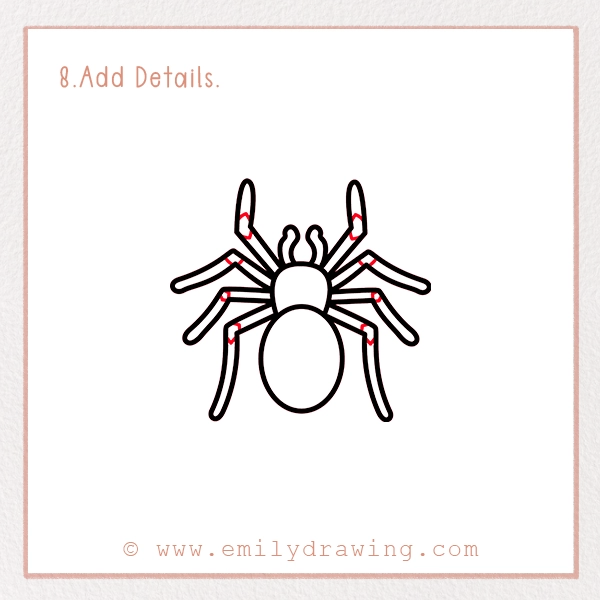
To make your tarantula look more realistic, add small segments to the legs, tiny hairs on its body, and some texture on the abdomen. You can also add some shadows or darker areas to give it a more three-dimensional look.
Fun Fact: Some tarantulas can flick tiny barbed hairs from their bodies to defend themselves from predators!
Step 9 – Color Your Drawing!

Tarantulas come in all sorts of colors—brown, black, even blue! Use your favorite colors to bring your drawing to life. You can also add some shading or highlights to make it more dynamic.
Tip: Try using different shades of brown or grey for a more natural look. If you want a unique tarantula, experiment with exotic colors like bright blue or red!
Pin it now, Draw later!
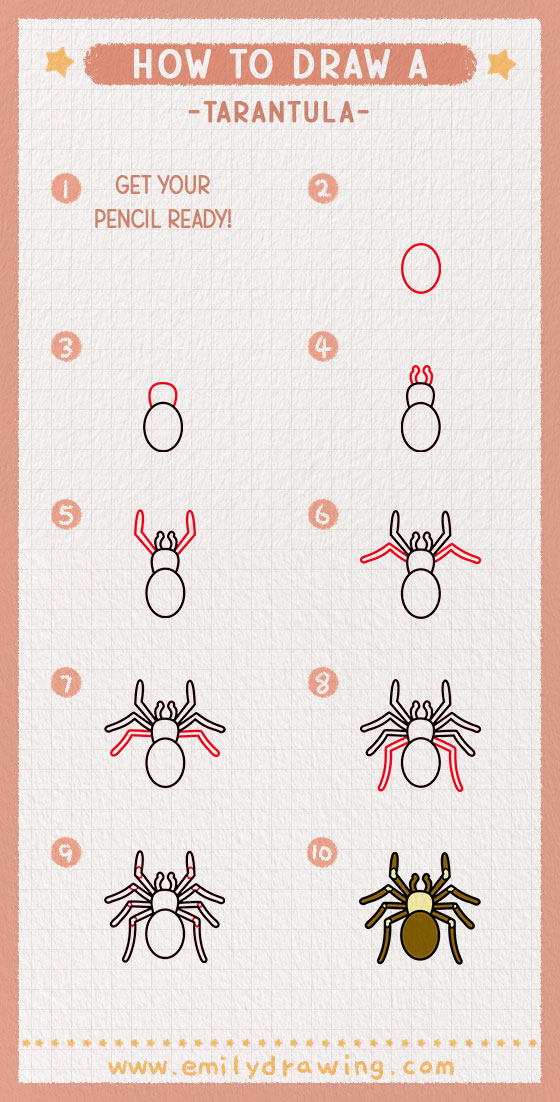
Fun Facts About Tarantulas
- Tarantulas have been around for over 100 million years! They existed even before dinosaurs went extinct.
- Despite their scary look, tarantulas are not dangerous to humans. Their venom is milder than a bee sting!
- Some tarantulas can live up to 30 years! That’s longer than most pet dogs or cats.
- Tarantulas don’t build webs like other spiders. Instead, they burrow underground and use silk to create a cozy home.
- The Goliath bird eater is the world’s largest tarantula, growing up to 11 inches wide!
Tips and Tricks for Better Drawing
- Use light pencil strokes so you can erase mistakes easily before finishing your drawing.
- Break down complex shapes into simple ones. Ovals, circles, and curved lines will make it easier to sketch your tarantula.
- Take your time drawing spider legs—they should be symmetrical but not perfectly straight. The more natural they look, the better.
- Experiment with different shading techniques to add depth and make your tarantula appear more three-dimensional.
- Try using reference images of real tarantulas to make your drawing even more realistic.
- If you want to add an extra creepy effect, draw your tarantula crawling on a web or a tree branch!
Great job! You’ve just drawn an awesome tarantula. We hope you had fun following along. Drawing takes practice, so keep sketching and improving your skills. Don’t forget to show off your masterpiece! Share your drawing on social media using #EmilyDrawing or challenge your friends to draw their own tarantulas.
If you enjoyed this tutorial, check out more fun drawing guides! You can try drawing other cool animals like scorpions, beetles, or even a dragon—or expand your arachnid collection with our fun guide on drawing a spider.
